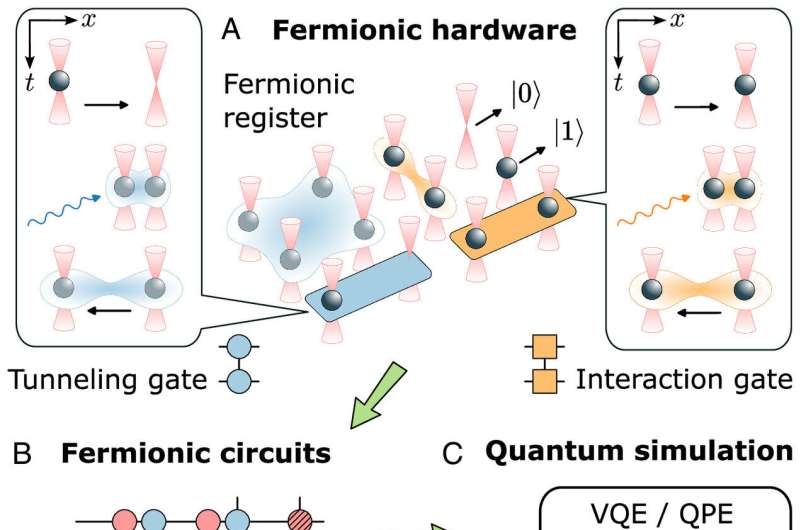This article has been reviewed according to Science X's editorial process and policies. Editors have highlighted the following attributes while ensuring the content's credibility:
fact-checked
peer-reviewed publication
trusted source
proofread
Scientists develop fermionic quantum processor

Researchers from Austria and the U.S. have designed a new type of quantum computer that uses fermionic atoms to simulate complex physical systems. The processor uses programmable neutral atom arrays and is capable of simulating fermionic models in a hardware-efficient manner using fermionic gates.
The team led by Peter Zoller demonstrated how the new quantum processor can efficiently simulate fermionic models from quantum chemistry and particle physics. The paper is published in the journal Proceedings of the National Academy of Sciences.
Fermionic atoms are atoms that obey the Pauli exclusion principle, which means that no two of them can occupy the same quantum state simultaneously. This makes them ideal for simulating systems where fermionic statistics play a crucial role, such as molecules, superconductors and quark-gluon plasmas.
"In qubit-based quantum computers extra resources need to be dedicated to simulate these properties, usually in the form of additional qubits or longer quantum circuits," explains Daniel Gonzalez Cuadra from the research group led by Zoller at the Institute for Quantum Optics and Quantum Information (IQOQI) of the Austrian Academy of Sciences (ÖAW) and the Department of Theoretical Physics at the University of Innsbruck, Austria.
Quantum information in fermionic particles
A fermionic quantum processor is composed of a fermionic register and a set of fermionic quantum gates. "The register consists on a set of fermionic modes, which can be either empty or occupied by a single fermion, and these two states form the local unit of quantum information," says Gonzalez Cuadra. "The state of the system we want to simulate, such as a molecule composed of many electrons, will be in general a superposition of many occupation patterns, which can be directly encoded into this register."
This information is then processed using a fermionic quantum circuit, designed to simulate for example the time evolution of a molecule. Any such circuit can be decomposed into a sequence of just two types of fermionic gates, a tunneling and an interaction gate.
The researchers propose to trap fermionic atoms in an array of optical tweezers, which are highly focused laser beams that can hold and move atoms with high precision. "The required set of fermionic quantum gates can be natively implemented in this platform: tunneling gates can be obtained by controlling the tunneling of an atom between two optical tweezers, while interaction gates are implemented by first exciting the atoms to Rydberg states, carrying a strong dipole moment," says Gonzalez Cuadra.
Quantum chemistry to particle physics
Fermionic quantum processing is particularly useful to simulate the properties of systems composed of many interacting fermions, such as electrons in a molecule or in a material, or quarks inside a proton, and has therefore applications in many fields, ranging from quantum chemistry to particle physics. The researchers demonstrate how their fermionic quantum processor can efficiently simulate fermionic models from quantum chemistry and lattice gauge theory, which are two important fields of physics that are hard to solve with classical computers.
"By using fermions to encode and process quantum information, some properties of the simulated system are intrinsically guaranteed at the hardware level, which would require additional resources in a standard qubit-based quantum computer," says Gonzalez Cuadra.
"I am very excited about the future of the field, and I would like to keep contributing to it by identifying the most promising applications for fermionic quantum processing, and by designing tailored algorithms that can run in near-term devices."
More information: D. González-Cuadra et al, Fermionic quantum processing with programmable neutral atom arrays, Proceedings of the National Academy of Sciences (2023). DOI: 10.1073/pnas.2304294120
Journal information: Proceedings of the National Academy of Sciences
Provided by University of Innsbruck





















